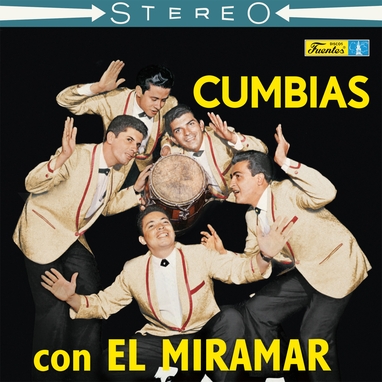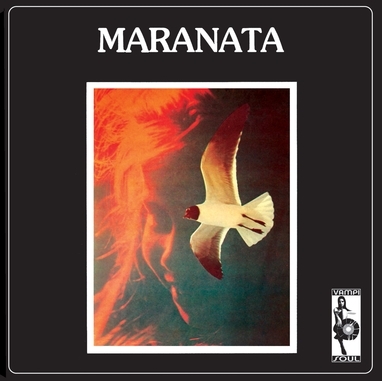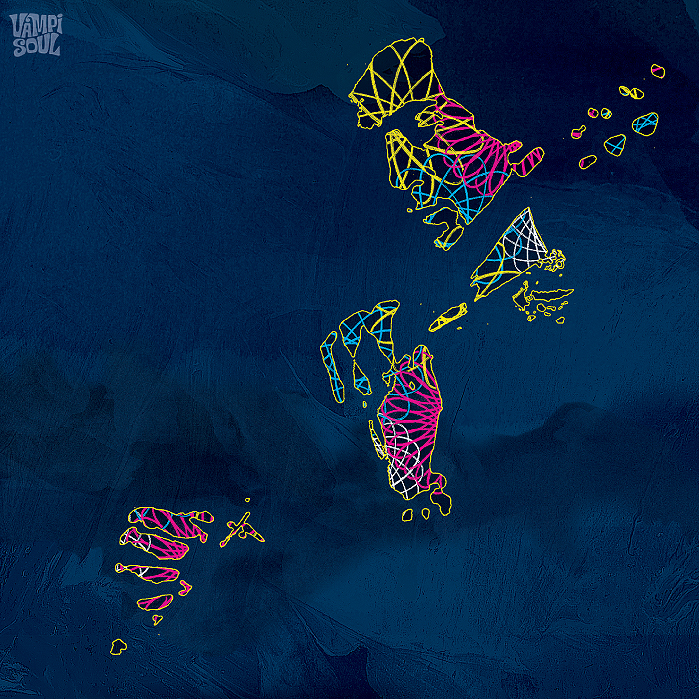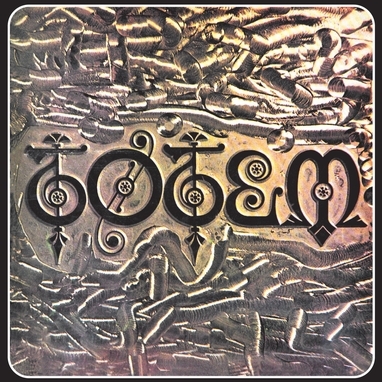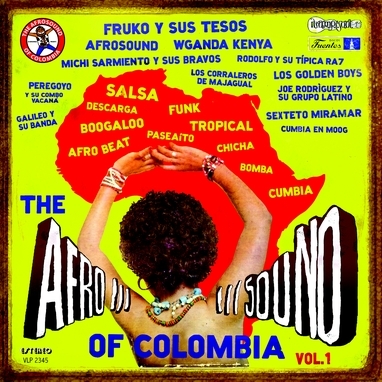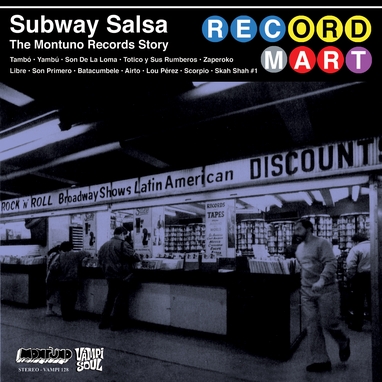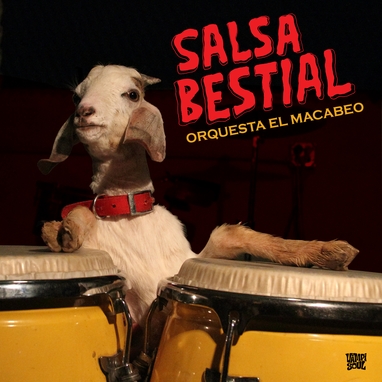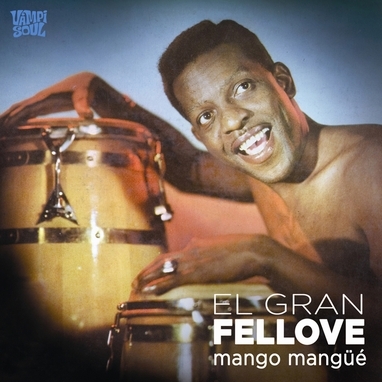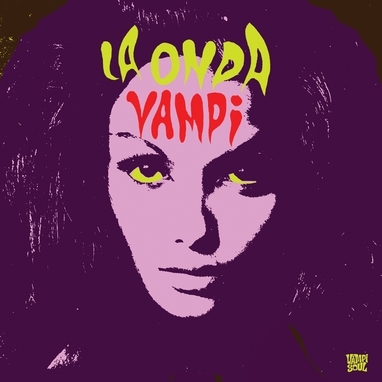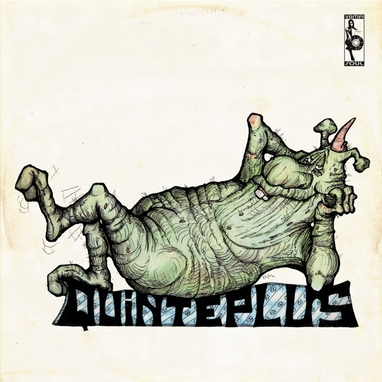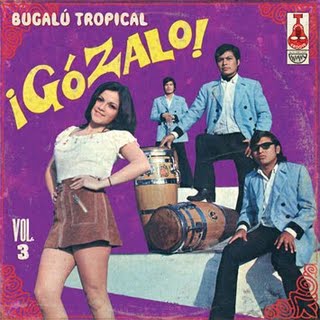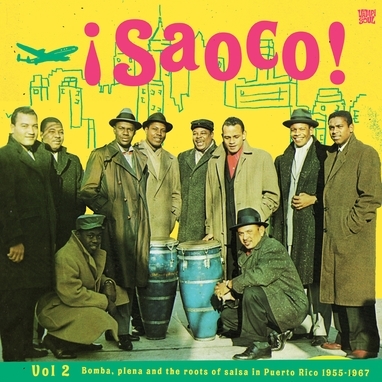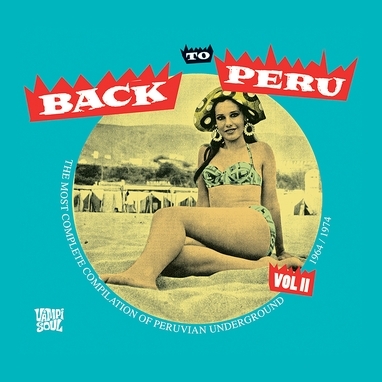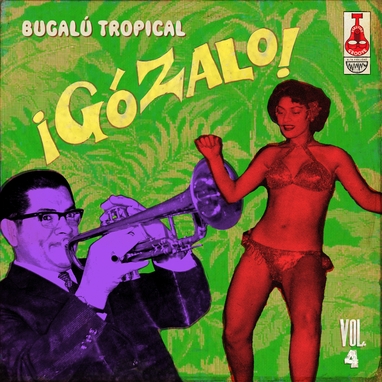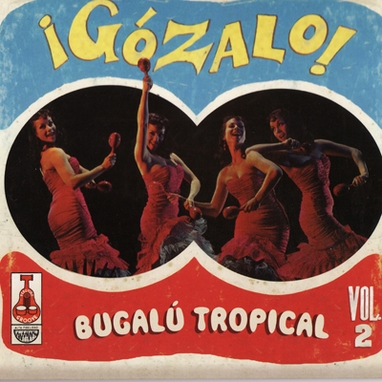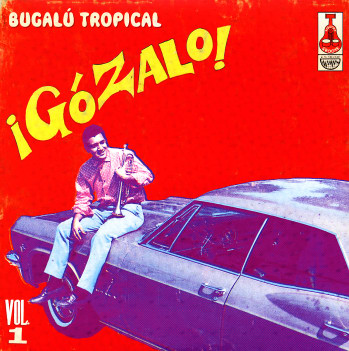Conjunto Miramar
Cumbias con El Miramar
19,00€
Vampisoul
Conjunto Miramar
Cumbias con El Miramar
First ever reissue of Cumbias con el Miramar, a very hard-to-find album released by Discos Fuentes in 1965. Full of excellent cumbias and gaitas for dancing, the record actually is a lot more diverse than the title leads one to believe, as there are lots of other hot rhythms and arrangements on it, taken from Cuban genres like guajira, guaracha, guaguancó, charanga and son montuno. Presented in facsimile artwork and pressed on 180g vinyl. Part of Vampisoul’s reissue series of classic Fuentes LPs.
Cumbias con el Miramar is a very hard-to-find, sought-after album released by Discos Fuentes in 1965. Full of excellent cumbias and gaitas for dancing, the record actually is a lot more diverse than the title leads one to believe, as there are lots of other hot rhythms and arrangements on it, taken from Cuban genres like guajira, guaracha, guaguancó, charanga and son montuno. All but one of its compositions come from the conjunto’s own musicians, with the bulk being written by Hernán Builes and Héctor Quintero. Throughout the album the very simple, spare elemental sound is consistent. The band members at this time included Darío Restrepo (aka Guayabita) on piano, Rubén Darío Restrepo (El Mago) on guitar, Héctor Quintero on saxophone, clarinet, flute, xylophone and vocals, Hugo Gil (Chamizo) behind the drum set as well as on tumbadora (conga) and vocals, with Hernán Builes being the band’s director and bassist (and occasional accordionist). Darío Restrepo has said that the xylophone used on this record was a small children’s model that the band purchased in Medellín, and there is an engagingly youthful exuberance, brevity and playful simplicity on this album that belies the band members’ obvious maturity and the prodigious talent displayed therein. The childlike aspect to the band is indeed appropriate because Conjunto Miramar was formed by a group of very young music enthusiasts (some under the age of 10!) in 1957 in Manizales (although some sources say Medellín). The Miramar boys were all childhood friends that wanted to play music together during the holidays, led by Medellín native Jairo Grisales (accordion) and bassist Hernán Builes. They were joined by an ever-changing line-up that included siblings Jairo Darío Gil aka Dargil and Hugo Gil, as well as Hernán Pabón, Augusto Zapata, Roberto de la Barrera and Héctor Quintero. Conjunto Miramar recorded their first singles for the Medellín-based Discos Ondina label in 1961. These Ondina 45 singles were later collected on an album titled Carruseles (Sonico/INS, 1977); however, their first proper long play recording was for the Zeida label (probably recorded in 1962/63) but by then Grisales had left the group and Hernán Builes took over, signing with Discos Fuentes in 1965. Soon after Cumbias con el Miramar was released, Builes reformatted the line-up and instrumentation, updating the sound to reflect recent developments in Caracas, San Juan and New York, adding vibraphone in the fashion of The Joe Cuba Sextet (as well as hiring vocalists Humberto Huango Muriel, Rodolfo Aicardi and Johnny Moré), renaming the group Sexteto Mirarmar and debuting the groundbreaking album ¡Salsa! Mi Hermana (the band left Fuentes in 1969 after four more successful records). Interestingly, Cumbias con el Miramar contains superior versions of ‘Cumbia del sol’ – arguably one of the band’s most famous and internationally influential songs – and ‘Lelogua’, both of which had also been recorded earlier for their Zeida LP. In addition, several other tunes from the record – ‘Cumbia loca’, ‘Cumbia de estrellas’ and ‘Noche y cumbia’ – have been popular among DJs, sonideros and dancers for 50 years. But while these cumbias form the backbone of the album and situate it firmly in the folklore of the band’s native Colombia, the LP’s Cuban-styled songs like ‘Mensaje guajiro’ and ‘Lelogua’ point to the other obsession of Colombian audiences, namely that of Afro-Antillean music (that would be marketed as salsa in the following decade). The album offers us a fascinating snapshot of a pivotal period in Colombian music when outside influences (such as salsa from New York) and the wildly popular phenomenon of so-called raspa or chucu-chucu cumbia groups from the interior (described as paisa, i.e. not from the Afro-Colombian coastal regions where cumbia began) were initiating a transition from the old sound (and generation) to the new. Conjunto Miramar certainly influenced and inspired the rise of the youthful teenager raspa groups like Los Teenagers, Hispanos, Bobby Soxers, Graduados, Black Stars, Éxitos and Falcons, but at the same time, as the newly christened Sexteto Miramar, they helped inspire Discos Fuentes to usher in the new decade of the 1970s with the modern salsa dura of Fruko y Sus Tesos, as Fruko himself has admitted. Pablo Iglesias aka DJ Bongohead
Productos relacionados
19,00€
First ever reissue of Cumbias con el Miramar, a very hard-to-find album released by Discos Fuentes in 1965. Full of excellent cumbias and gaitas for dancing, the record actually is a lot more diverse than the title leads one to believe, as there are lots of other hot rhythms and arrangements on it, taken from Cuban genres like guajira, guaracha, guaguancó, charanga and son montuno. Presented in facsimile artwork and pressed on 180g vinyl. Part of Vampisoul’s reissue series of classic Fuentes LPs.
Cumbias con el Miramar is a very hard-to-find, sought-after album released by Discos Fuentes in 1965. Full of excellent cumbias and gaitas for dancing, the record actually is a lot more diverse than the title leads one to believe, as there are lots of other hot rhythms and arrangements on it, taken from Cuban genres like guajira, guaracha, guaguancó, charanga and son montuno. All but one of its compositions come from the conjunto’s own musicians, with the bulk being written by Hernán Builes and Héctor Quintero. Throughout the album the very simple, spare elemental sound is consistent. The band members at this time included Darío Restrepo (aka Guayabita) on piano, Rubén Darío Restrepo (El Mago) on guitar, Héctor Quintero on saxophone, clarinet, flute, xylophone and vocals, Hugo Gil (Chamizo) behind the drum set as well as on tumbadora (conga) and vocals, with Hernán Builes being the band’s director and bassist (and occasional accordionist). Darío Restrepo has said that the xylophone used on this record was a small children’s model that the band purchased in Medellín, and there is an engagingly youthful exuberance, brevity and playful simplicity on this album that belies the band members’ obvious maturity and the prodigious talent displayed therein. The childlike aspect to the band is indeed appropriate because Conjunto Miramar was formed by a group of very young music enthusiasts (some under the age of 10!) in 1957 in Manizales (although some sources say Medellín). The Miramar boys were all childhood friends that wanted to play music together during the holidays, led by Medellín native Jairo Grisales (accordion) and bassist Hernán Builes. They were joined by an ever-changing line-up that included siblings Jairo Darío Gil aka Dargil and Hugo Gil, as well as Hernán Pabón, Augusto Zapata, Roberto de la Barrera and Héctor Quintero. Conjunto Miramar recorded their first singles for the Medellín-based Discos Ondina label in 1961. These Ondina 45 singles were later collected on an album titled Carruseles (Sonico/INS, 1977); however, their first proper long play recording was for the Zeida label (probably recorded in 1962/63) but by then Grisales had left the group and Hernán Builes took over, signing with Discos Fuentes in 1965. Soon after Cumbias con el Miramar was released, Builes reformatted the line-up and instrumentation, updating the sound to reflect recent developments in Caracas, San Juan and New York, adding vibraphone in the fashion of The Joe Cuba Sextet (as well as hiring vocalists Humberto Huango Muriel, Rodolfo Aicardi and Johnny Moré), renaming the group Sexteto Mirarmar and debuting the groundbreaking album ¡Salsa! Mi Hermana (the band left Fuentes in 1969 after four more successful records). Interestingly, Cumbias con el Miramar contains superior versions of ‘Cumbia del sol’ – arguably one of the band’s most famous and internationally influential songs – and ‘Lelogua’, both of which had also been recorded earlier for their Zeida LP. In addition, several other tunes from the record – ‘Cumbia loca’, ‘Cumbia de estrellas’ and ‘Noche y cumbia’ – have been popular among DJs, sonideros and dancers for 50 years. But while these cumbias form the backbone of the album and situate it firmly in the folklore of the band’s native Colombia, the LP’s Cuban-styled songs like ‘Mensaje guajiro’ and ‘Lelogua’ point to the other obsession of Colombian audiences, namely that of Afro-Antillean music (that would be marketed as salsa in the following decade). The album offers us a fascinating snapshot of a pivotal period in Colombian music when outside influences (such as salsa from New York) and the wildly popular phenomenon of so-called raspa or chucu-chucu cumbia groups from the interior (described as paisa, i.e. not from the Afro-Colombian coastal regions where cumbia began) were initiating a transition from the old sound (and generation) to the new. Conjunto Miramar certainly influenced and inspired the rise of the youthful teenager raspa groups like Los Teenagers, Hispanos, Bobby Soxers, Graduados, Black Stars, Éxitos and Falcons, but at the same time, as the newly christened Sexteto Miramar, they helped inspire Discos Fuentes to usher in the new decade of the 1970s with the modern salsa dura of Fruko y Sus Tesos, as Fruko himself has admitted. Pablo Iglesias aka DJ Bongohead
Productos relacionados
Cumbias con El Miramar
First ever reissue of Cumbias con el Miramar, a very hard-to-find album released by Discos Fuentes in 1965. Full of excellent cumbias and gaitas for dancing, the record actually is a lot more diverse than the title leads one to believe, as there are lots of other hot rhythms and arrangements on it, taken from Cuban genres like guajira, guaracha, guaguancó, charanga and son montuno. Presented in facsimile artwork and pressed on 180g vinyl. Part of Vampisoul’s reissue series of classic Fuentes LPs.
Cumbias con el Miramar is a very hard-to-find, sought-after album released by Discos Fuentes in 1965. Full of excellent cumbias and gaitas for dancing, the record actually is a lot more diverse than the title leads one to believe, as there are lots of other hot rhythms and arrangements on it, taken from Cuban genres like guajira, guaracha, guaguancó, charanga and son montuno. All but one of its compositions come from the conjunto’s own musicians, with the bulk being written by Hernán Builes and Héctor Quintero. Throughout the album the very simple, spare elemental sound is consistent. The band members at this time included Darío Restrepo (aka Guayabita) on piano, Rubén Darío Restrepo (El Mago) on guitar, Héctor Quintero on saxophone, clarinet, flute, xylophone and vocals, Hugo Gil (Chamizo) behind the drum set as well as on tumbadora (conga) and vocals, with Hernán Builes being the band’s director and bassist (and occasional accordionist). Darío Restrepo has said that the xylophone used on this record was a small children’s model that the band purchased in Medellín, and there is an engagingly youthful exuberance, brevity and playful simplicity on this album that belies the band members’ obvious maturity and the prodigious talent displayed therein. The childlike aspect to the band is indeed appropriate because Conjunto Miramar was formed by a group of very young music enthusiasts (some under the age of 10!) in 1957 in Manizales (although some sources say Medellín). The Miramar boys were all childhood friends that wanted to play music together during the holidays, led by Medellín native Jairo Grisales (accordion) and bassist Hernán Builes. They were joined by an ever-changing line-up that included siblings Jairo Darío Gil aka Dargil and Hugo Gil, as well as Hernán Pabón, Augusto Zapata, Roberto de la Barrera and Héctor Quintero. Conjunto Miramar recorded their first singles for the Medellín-based Discos Ondina label in 1961. These Ondina 45 singles were later collected on an album titled Carruseles (Sonico/INS, 1977); however, their first proper long play recording was for the Zeida label (probably recorded in 1962/63) but by then Grisales had left the group and Hernán Builes took over, signing with Discos Fuentes in 1965. Soon after Cumbias con el Miramar was released, Builes reformatted the line-up and instrumentation, updating the sound to reflect recent developments in Caracas, San Juan and New York, adding vibraphone in the fashion of The Joe Cuba Sextet (as well as hiring vocalists Humberto Huango Muriel, Rodolfo Aicardi and Johnny Moré), renaming the group Sexteto Mirarmar and debuting the groundbreaking album ¡Salsa! Mi Hermana (the band left Fuentes in 1969 after four more successful records). Interestingly, Cumbias con el Miramar contains superior versions of ‘Cumbia del sol’ – arguably one of the band’s most famous and internationally influential songs – and ‘Lelogua’, both of which had also been recorded earlier for their Zeida LP. In addition, several other tunes from the record – ‘Cumbia loca’, ‘Cumbia de estrellas’ and ‘Noche y cumbia’ – have been popular among DJs, sonideros and dancers for 50 years. But while these cumbias form the backbone of the album and situate it firmly in the folklore of the band’s native Colombia, the LP’s Cuban-styled songs like ‘Mensaje guajiro’ and ‘Lelogua’ point to the other obsession of Colombian audiences, namely that of Afro-Antillean music (that would be marketed as salsa in the following decade). The album offers us a fascinating snapshot of a pivotal period in Colombian music when outside influences (such as salsa from New York) and the wildly popular phenomenon of so-called raspa or chucu-chucu cumbia groups from the interior (described as paisa, i.e. not from the Afro-Colombian coastal regions where cumbia began) were initiating a transition from the old sound (and generation) to the new. Conjunto Miramar certainly influenced and inspired the rise of the youthful teenager raspa groups like Los Teenagers, Hispanos, Bobby Soxers, Graduados, Black Stars, Éxitos and Falcons, but at the same time, as the newly christened Sexteto Miramar, they helped inspire Discos Fuentes to usher in the new decade of the 1970s with the modern salsa dura of Fruko y Sus Tesos, as Fruko himself has admitted. Pablo Iglesias aka DJ Bongohead
First ever reissue of Cumbias con el Miramar, a very hard-to-find album released by Discos Fuentes in 1965. Full of excellent cumbias and gaitas for dancing, the record actually is a lot more diverse than the title leads one to believe, as there are lots of other hot rhythms and arrangements on it, taken from Cuban genres like guajira, guaracha, guaguancó, charanga and son montuno. Presented in facsimile artwork and pressed on 180g vinyl. Part of Vampisoul’s reissue series of classic Fuentes LPs.
Cumbias con el Miramar is a very hard-to-find, sought-after album released by Discos Fuentes in 1965. Full of excellent cumbias and gaitas for dancing, the record actually is a lot more diverse than the title leads one to believe, as there are lots of other hot rhythms and arrangements on it, taken from Cuban genres like guajira, guaracha, guaguancó, charanga and son montuno. All but one of its compositions come from the conjunto’s own musicians, with the bulk being written by Hernán Builes and Héctor Quintero. Throughout the album the very simple, spare elemental sound is consistent. The band members at this time included Darío Restrepo (aka Guayabita) on piano, Rubén Darío Restrepo (El Mago) on guitar, Héctor Quintero on saxophone, clarinet, flute, xylophone and vocals, Hugo Gil (Chamizo) behind the drum set as well as on tumbadora (conga) and vocals, with Hernán Builes being the band’s director and bassist (and occasional accordionist). Darío Restrepo has said that the xylophone used on this record was a small children’s model that the band purchased in Medellín, and there is an engagingly youthful exuberance, brevity and playful simplicity on this album that belies the band members’ obvious maturity and the prodigious talent displayed therein. The childlike aspect to the band is indeed appropriate because Conjunto Miramar was formed by a group of very young music enthusiasts (some under the age of 10!) in 1957 in Manizales (although some sources say Medellín). The Miramar boys were all childhood friends that wanted to play music together during the holidays, led by Medellín native Jairo Grisales (accordion) and bassist Hernán Builes. They were joined by an ever-changing line-up that included siblings Jairo Darío Gil aka Dargil and Hugo Gil, as well as Hernán Pabón, Augusto Zapata, Roberto de la Barrera and Héctor Quintero. Conjunto Miramar recorded their first singles for the Medellín-based Discos Ondina label in 1961. These Ondina 45 singles were later collected on an album titled Carruseles (Sonico/INS, 1977); however, their first proper long play recording was for the Zeida label (probably recorded in 1962/63) but by then Grisales had left the group and Hernán Builes took over, signing with Discos Fuentes in 1965. Soon after Cumbias con el Miramar was released, Builes reformatted the line-up and instrumentation, updating the sound to reflect recent developments in Caracas, San Juan and New York, adding vibraphone in the fashion of The Joe Cuba Sextet (as well as hiring vocalists Humberto Huango Muriel, Rodolfo Aicardi and Johnny Moré), renaming the group Sexteto Mirarmar and debuting the groundbreaking album ¡Salsa! Mi Hermana (the band left Fuentes in 1969 after four more successful records). Interestingly, Cumbias con el Miramar contains superior versions of ‘Cumbia del sol’ – arguably one of the band’s most famous and internationally influential songs – and ‘Lelogua’, both of which had also been recorded earlier for their Zeida LP. In addition, several other tunes from the record – ‘Cumbia loca’, ‘Cumbia de estrellas’ and ‘Noche y cumbia’ – have been popular among DJs, sonideros and dancers for 50 years. But while these cumbias form the backbone of the album and situate it firmly in the folklore of the band’s native Colombia, the LP’s Cuban-styled songs like ‘Mensaje guajiro’ and ‘Lelogua’ point to the other obsession of Colombian audiences, namely that of Afro-Antillean music (that would be marketed as salsa in the following decade). The album offers us a fascinating snapshot of a pivotal period in Colombian music when outside influences (such as salsa from New York) and the wildly popular phenomenon of so-called raspa or chucu-chucu cumbia groups from the interior (described as paisa, i.e. not from the Afro-Colombian coastal regions where cumbia began) were initiating a transition from the old sound (and generation) to the new. Conjunto Miramar certainly influenced and inspired the rise of the youthful teenager raspa groups like Los Teenagers, Hispanos, Bobby Soxers, Graduados, Black Stars, Éxitos and Falcons, but at the same time, as the newly christened Sexteto Miramar, they helped inspire Discos Fuentes to usher in the new decade of the 1970s with the modern salsa dura of Fruko y Sus Tesos, as Fruko himself has admitted. Pablo Iglesias aka DJ Bongohead

